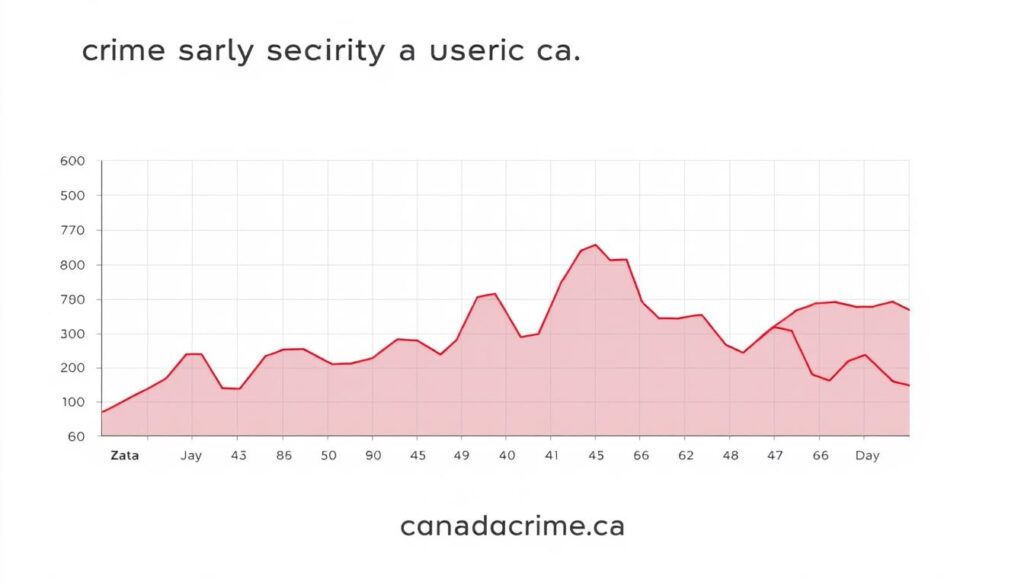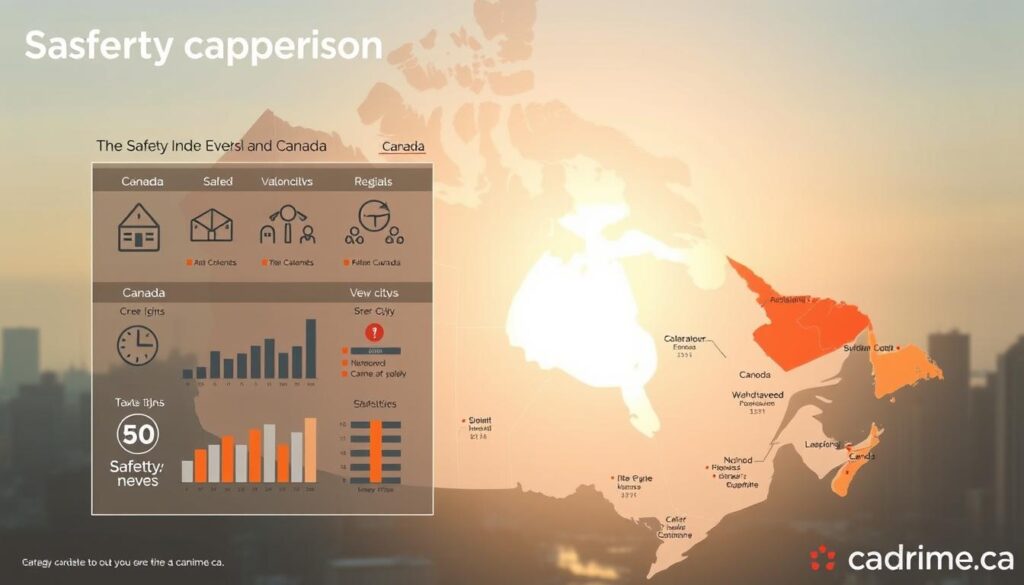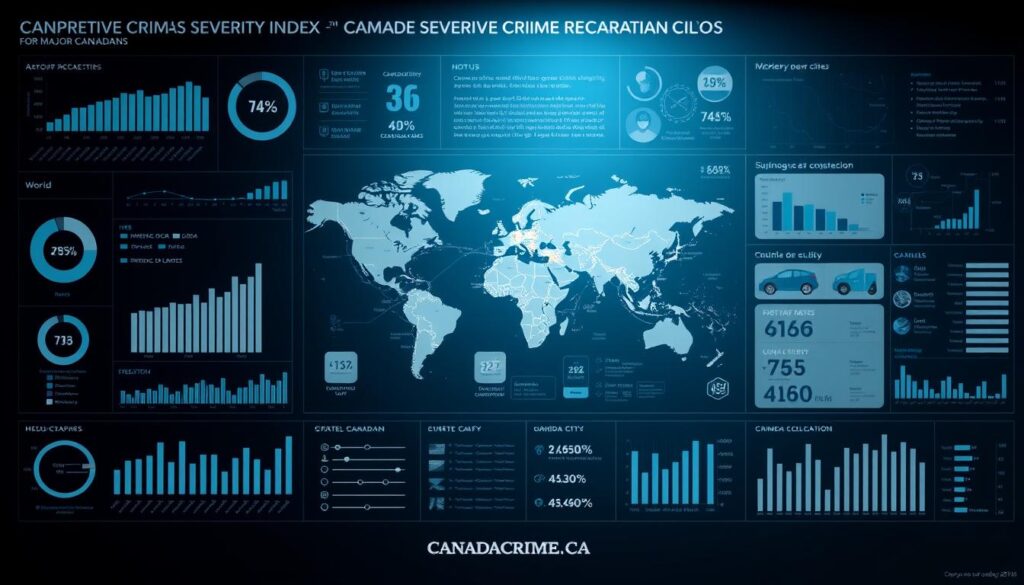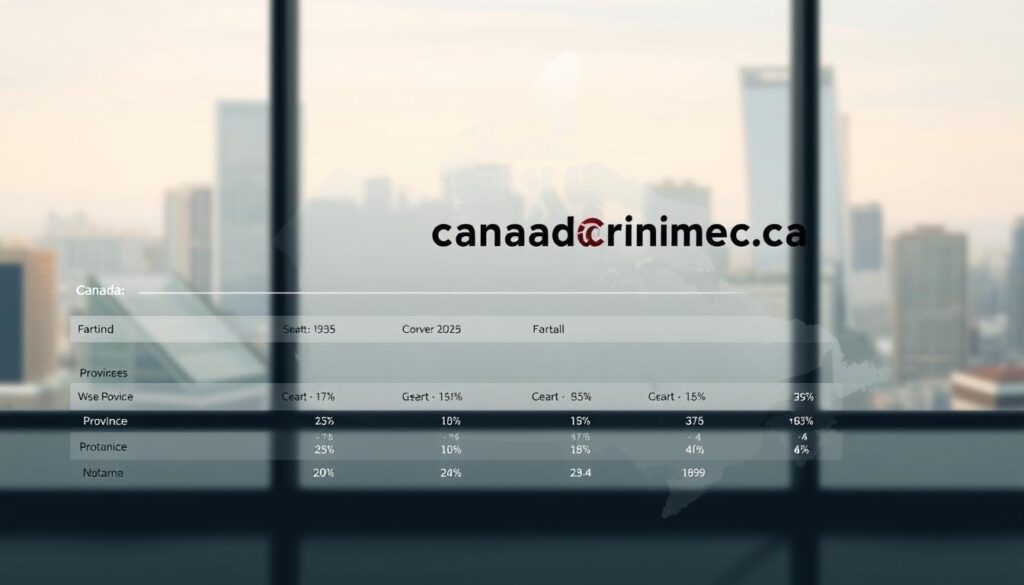Did you know that some Canadian urban areas have crime severity indexes higher than 70% of U.S. cities? While Canada is globally celebrated for its safety, certain regions face unique challenges that contrast sharply with this reputation. Understanding these trends helps you stay informed about risks and community dynamics.
This article focuses on locations where crime rates stand out nationally. You’ll learn how safety metrics vary between neighborhoods and provinces. We’ll use data from CanadaCrime.ca, a trusted resource for analyzing trends like violent offenses and property-related incidents.
Why does this matter? Elevated crime impacts housing costs, local businesses, and quality of life. By exploring factual examples and indexes, you’ll gain clarity on which areas require extra caution. Our analysis avoids sensationalism—just clear insights to help you make informed decisions.
Key Takeaways
- Canada’s safety reputation doesn’t apply uniformly across all regions.
- Crime severity indexes reveal stark contrasts between urban areas.
- Violent and property crimes are analyzed separately for accuracy.
- CanadaCrime.ca provides up-to-date, localized data.
- Community impacts include economic and social consequences.
Introduction to Crime Trends in Canada
When assessing safety, it’s not just how many incidents occur—it’s the weight of each offense that reveals true risks. Metrics like the Crime Severity Index (CSI) go beyond simple counts by factoring in the seriousness of different crimes. This approach helps explain why two areas with similar crime numbers might feel drastically different to residents.

Understanding Crime Rates and Safety Indexes
Crime rates measure incidents per 100,000 people, but the CSI adds depth. For example, a robbery impacts the index more than a bicycle theft. In 2023, violent offenses had a CSI score 2.6 times higher than non-violent ones nationally. Here’s how provinces compared:
| Province | Violent CSI (2023) | Non-Violent CSI (2023) |
|---|---|---|
| Nunavut | 429.1 | 92.4 |
| Ontario | 60.9 | 24.3 |
| Saskatchewan | 160.2 | 60.9 |
The Role of Data in Shaping Perceptions
Year-over-year comparisons show trends. Canada’s overall CSI rose 2% from 2022 to 2023, signaling shifting risks. Platforms like CanadaCrime.ca make this data accessible, helping you spot patterns in your region. Policymakers use these insights to fund prevention programs, while residents gauge neighborhood safety.
Understanding these metrics empowers you to ask better questions. Why does one area’s CSI climb while another’s drops? How do local initiatives impact numbers? Reliable sources turn raw stats into actionable knowledge.
Background: Canada’s Reputation for Safety and Its Complexities
Canada often ranks among the safest countries globally, yet hidden challenges shape its urban security landscape. While the nation scores 82/100 on global safety indexes—higher than the U.S. (53/100)—localized risks persist. These variations remind us that safety isn’t uniform, even in countries with strong reputations.

Safety Metrics Across Borders
Consider this: Canada’s violent crime rate is 1.1 incidents per 1,000 people, compared to 4.0 in the U.S. However, specific urban zones exceed national averages. For example:
| Metric | Canada (Avg) | U.S. (Avg) |
|---|---|---|
| Homicides per 100k | 1.8 | 6.3 |
| Burglary Rate | 395 | 430 |
| Assaults per 100k | 450 | 800 |
Why the gap? Stricter gun laws and social programs contribute to Canada’s lower violent crime rates. But property crimes like theft remain elevated in metro areas. Toronto reports 2,200 vehicle thefts monthly—a 34% jump since 2021.
Safety indexes help decode these patterns. They weigh factors like police response times and community trust. Cities with higher population density often see more property crimes, while rural areas face fewer but sometimes severe incidents.
Understanding these layers lets you navigate risks wisely. Just as weather varies across regions, so does security. Reliable data turns broad perceptions into actionable insights.
Factors Influencing Crime Rates in Canadian Cities
Crime patterns don’t emerge randomly—they’re shaped by intersecting social and systemic forces. Socioeconomic gaps and policing strategies create visible differences in safety metrics across regions. Let’s explore how these elements interact to shape risks.

Socioeconomic Conditions and Population Density
Areas with higher poverty levels often report elevated violent crimes. For example, Winnipeg’s downtown core—where 25% of households earn below $30k annually—has a robbery rate 3x the national average. Dense urban zones also see more property crime due to accessibility. Vancouver’s Downtown Eastside records 12% higher theft rates than suburban neighborhoods.
| City | Median Income | Violent Crime Rate (per 100k) |
|---|---|---|
| Regina | $52,000 | 1,420 |
| Ottawa | $85,000 | 680 |
Local Law Enforcement Effectiveness
Police response times and community trust impact outcomes. Toronto’s dedicated gang-violence task force reduced shootings by 18% in 2023. Conversely, understaffed rural precincts in Saskatchewan face clearance rates 22% lower than urban counterparts.
Data shows cities investing in neighborhood patrols cut property crime by 14% within two years. Challenges like cybercrime demand specialized training—only 40% of departments have full-time digital forensics teams.
Data-Driven Analysis of Canadian Crime
Numbers tell stories, and Canada’s Crime Severity Index (CSI) reveals critical insights about urban risks. Unlike basic crime counts, this metric assigns weight to offenses based on their societal impact. A shoplifting incident scores lower than an armed robbery, for example. This approach helps you compare safety trends accurately across regions.

Interpreting the Crime Severity Index (CSI)
The CSI measures both volume and seriousness of offenses. In 2023, violent crimes contributed 58% to national CSI scores despite making up only 22% of total incidents. Here’s how property and violent offenses compare in three cities:
| City | Violent CSI | Property CSI |
|---|---|---|
| Winnipeg | 142 | 89 |
| Regina | 135 | 76 |
| Vancouver | 118 | 102 |
Data comes from police reports, court records, and victim surveys. CanadaCrime.ca standardizes this information, creating comparable rates per 100,000 residents. Cities with CSI scores above 100 appear on high-risk lists, signaling areas needing targeted interventions.
Why does this matter? A rising CSI often predicts economic strain. Neighborhoods with scores over 120 see 15% faster insurance premium growth. By tracking these trends, you can assess risks for home purchases or business expansions.
Policymakers use CSI breakdowns to fund prevention programs. A 10% drop in property crime CSI could save municipalities $2.4 million annually. For residents, understanding local scores helps choose safer routes or secure homes effectively.
Spotlight on Top Crime Cities in Canada
Urban safety varies widely across the country, with some communities facing higher risks than others. Recent data from CanadaCrime.ca highlights locations like Red Deer and Kelowna, where shifting crime patterns demand attention. Let’s explore how these areas compare and what it means for those living there.
Yearly Shifts in Urban Security
Red Deer’s Crime Severity Index (CSI) jumped 12% since 2022, driven by increased break-ins and assaults. Kelowna saw a 9% rise in property-related offenses, while North Battleford reduced violent incidents by 7% through targeted policing. These fluctuations show how quickly local issues can evolve.

| City | 2023 CSI | Violent Trend | Property Trend |
|---|---|---|---|
| Red Deer | 142 | +14% | +8% |
| Kelowna | 128 | +5% | +12% |
| Thompson | 167 | -3% | +6% |
Breaking Down Offense Categories
Violent crimes like assaults impact community well-being more directly than thefts. Regina residents report 23% longer police response times for violent calls compared to non-violent ones. In contrast, Winnipeg’s auto theft surge—up 34% yearly—shows how property issues strain resources differently.
These challenges affect daily life. Neighborhoods with rising CSIs often see reduced park usage and business closures. For current safe cities list, check regional updates. Understanding these trends helps you assess risks in potential relocation areas or vacation spots.
Provincial and Territorial Comparisons of Crime
Crime patterns shift dramatically when you cross provincial borders, revealing stark contrasts in community safety. The Northwest Territories reports a Crime Severity Index (CSI) of 389—triple the national average—while Ontario maintains a lower 85. These gaps highlight how geography and governance shape risks differently across regions.

High-Risk Regions and Emerging Trends
Theft drives CSI spikes in multiple provinces. Alberta saw a 17% increase in vehicle-related thefts last year, contributing to its overall CSI of 112. Meanwhile, Nunavut’s 420 CSI stems largely from violent offenses, though break-ins rose 9% in 2023.
| Region | Total CSI (2023) | Theft Rate per 100k |
|---|---|---|
| Northwest Territories | 389 | 1,840 |
| Nunavut | 420 | 890 |
| Alberta | 112 | 1,210 |
| Ontario | 85 | 670 |
Urban areas in Saskatchewan face unique challenges, with Regina’s CSI hitting 167 due to rising assaults. By contrast, rural Newfoundland reports fewer incidents but struggles with slow emergency response times.
Policy efforts vary widely. Manitoba launched nighttime patrols in high-theft zones, cutting break-ins by 14%. Quebec invests in youth programs to address root causes—a strategy showing early promise in Montreal’s suburbs.
Tracking these trends helps you understand regional risks. A 20% increase in Ontario’s cybercrime cases signals new challenges, while BC’s cargo theft reduction demonstrates effective countermeasures.
Urban vs. Suburban Crime Dynamics
Where you live shapes your safety experience—sometimes dramatically. Urban centers and suburban neighborhoods face distinct challenges, requiring tailored approaches to enforcement and prevention. Let’s explore how these environments differ and what it means for your daily life.

City Center Challenges
Dense urban zones like Vancouver’s Downtown Eastside grapple with organized crime and drug-related offenses. These areas see 3x more thefts and assaults than suburban regions. Police efforts focus on hotspot policing, with Vancouver deploying 24/7 surveillance in high-risk blocks. Yet, social issues like homelessness complicate enforcement strategies.
Suburban Safety Concerns
Suburbs face different issues. Surrey’s Clayton Heights reports rising garage break-ins and vandalism—up 18% since 2022. While violent crime rates are lower, residents express concerns about delayed emergency responses. Local law enforcement now partners with neighborhood watch groups to address these gaps.
| Metric | Urban Areas | Suburban Areas |
|---|---|---|
| Break-ins per 100k | 1,240 | 670 |
| Drug-related arrests | 420 | 85 |
| Police response time (min) | 9.2 | 14.7 |
Efforts to improve safety vary by setting. Urban task forces target gang activity, while suburban programs emphasize community education. Both require funding—cities allocate 34% more per capita to enforcement than suburbs. Your personal risk depends on these localized factors.
Impacts of Violent and Property Crimes
Violent and property crimes don’t just affect statistics—they reshape daily life. Imagine avoiding parks after dark or triple-checking door locks. These realities define neighborhoods where safety feels fragile.
Analyzing the Breakdown of Crime Types
Violent offenses like assaults create lasting trauma. In Winnipeg, 62% of residents near high-risk zones report anxiety about public spaces. Property crimes hit wallets harder—Edmonton saw a 19% insurance premium hike in areas with frequent break-ins.
| City | Assaults (2023) | Thefts (2023) | Drug Links |
|---|---|---|---|
| Kelowna | 840 | 2,150 | 28% |
| Winnipeg | 1,420 | 3,890 | 45% |
Drug-related offenses fuel broader concerns. Over 40% of thefts in Regina involve stolen items traded for opioids. This cycle strains social services and erodes living conditions. Families in affected areas face 23% higher childcare costs due to safety worries.
Addiction’s role can’t be ignored. Vancouver’s Downtown Eastside links 61% of property crimes to substance use. Programs combining housing and treatment cut repeat offenses by 34% in pilot areas. Addressing these roots improves community resilience.
Rising crime reshapes neighborhoods. Businesses close earlier, parks empty faster, and trust frays. Data-driven solutions—like targeted patrols and youth outreach—help rebuild security one block at a time.
Community Responses and Law Enforcement Strategies
Across Canadian communities, residents and police are redefining safety through collaboration. By blending technology with grassroots efforts, they’re tackling challenges seen in urban and rural regions alike. These partnerships show how localized strategies can create meaningful change.
Innovative Policing and Community Outreach
Police departments now use predictive analytics to prevent thefts before they occur. Edmonton’s “hotspot” patrols reduced vehicle break-ins by 22% in six months. Vancouver’s youth mentorship program connects officers with at-risk teens, cutting gang recruitment by 17%.
| City | Strategy | Outcome |
|---|---|---|
| Toronto | Bait car GPS tracking | 41% fewer auto thefts |
| Calgary | Neighborhood safety apps | 1,200+ tips monthly |
Community centers also play a role. Montreal’s after-school workshops teach conflict resolution, leading to fewer schoolyard assaults. These methods mirror global best practices from world leaders in urban safety.
Efforts to Address Drug-Related Offenses
Winnipeg’s outreach teams pair officers with addiction specialists. This approach connects substance users to treatment instead of jail cells. Early results show 31% fewer repeat offenses in targeted zones.
Hamilton’s “Safe Trade” zones let people exchange goods under camera surveillance. This simple idea reduced parking lot robberies by 19%. “We’re building trust while cutting opportunities for crime,” says a local sergeant.
Your involvement matters. Neighborhood watch groups using doorbell cameras helped solve 14% of vehicle theft cases in Ottawa last year. When communities and law enforcement align, everyone benefits.
Staying Informed and Safe in Your Community
Knowledge transforms numbers into shields—learn how safety metrics can guide your daily choices. Local security data isn’t just for policymakers; it’s your roadmap to smarter decisions about where to live, work, and explore.
Leveraging Safety Index Data for Personal Decisions
Start by decoding your area’s Crime Severity Index (CSI). A score above 100 signals higher-than-average risks. For example, neighborhoods with CSI spikes often see more late-night incidents. Check CanadaCrime.ca weekly for updates—their interactive maps show real-time shifts in thefts or assaults near schools and parks.
Here’s how to act on what you find:
- Compare daytime vs. nighttime CSI scores when choosing walking routes
- Use historical trends to assess if an area’s security is improving
- Set mobile alerts for new incident reports in your postal code
| Neighborhood | CSI (2024) | Theft Rate | Safety Tips |
|---|---|---|---|
| Downtown Core | 127 | 45/month | Avoid unlit alleys after 10 PM |
| Suburban West | 84 | 18/month | Install motion-sensor lights |
“Communities that track data together react faster,” notes a Toronto patrol sergeant. Join local watch groups using CanadaCrime.ca’s partnership portal—members receive early warnings about suspicious activity.
Your awareness creates ripple effects. When 60+ households in Halifax monitored break-in patterns, they reduced garage thefts by 31% in four months. Safety starts with one click, one conversation, one informed choice.
Conclusion
Safety isn’t just a statistic—it’s a lived experience shaped by informed choices. While Canada maintains strong safety benchmarks globally, urban challenges demand ongoing attention. Tools like the Crime Severity Index (CSI) reveal nuanced risks, helping you separate perception from reality.
Understanding these metrics empowers communities. When residents grasp how data reflects local trends, they advocate for better resources and targeted solutions. Addressing both violent incidents and property offenses requires collaborative strategies, not just enforcement.
Your awareness drives progress. Platforms like CanadaCrime.ca transform raw numbers into actionable insights, showing where patrols or prevention programs make the most impact. Regular updates let you track improvements or emerging risks in real time.
Stay engaged. Bookmark trusted sources, join neighborhood initiatives, and share knowledge. Every informed decision strengthens community resilience. Remember: data lights the path to safer streets, but vigilance keeps them secure.

